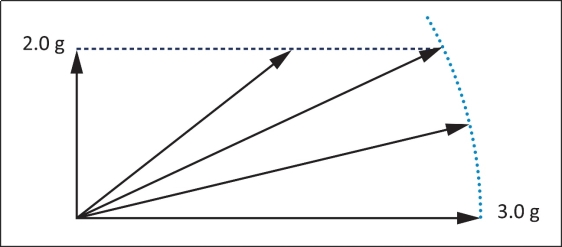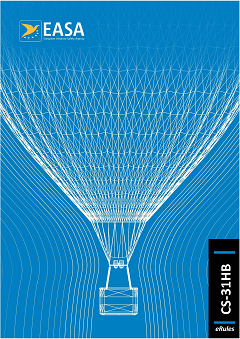ED Decision 2009/005/R
Strength requirements are specified in terms of:
(a) limit loads that are the maximum loads to be expected in service, taking into account the load factors of CS 31HB.23 and
(b) ultimate loads that are limit loads multiplied by factors of safety of CS 31HB.25.
ED Decision 2009/005/R
(a) Flight load factor. In determining limit loads, the limit load factor must be at least 1·4, except for (b).
(b) Landing load factor. For all parts belonging to the balloon’s suspension system, including the envelope to suspension system pick up points, limit load must be determined using a limit load factor of at least 3·0.
ED Decision 2011/013/R
(a) A factor of safety must be used in the balloon design as provided in the table.
|
|
Safety factor |
|
Envelope |
5.00 |
|
Suspension components (fibrous or non-metallic) |
2.25 |
|
Suspension components (metallic) |
1.50 |
|
Other |
1.50 |
(b) A reduced factor of 2 or more may be used in the envelope design if it is shown that the selected factor will preclude failure due to creep or instantaneous rupture from lack of rip stoppers. The selected factor must be applied to the more critical of the maximum operating pressure or envelope stress.
(c) The primary attachments of the envelope to the basket must be designed so that any single failure will not jeopardise safety of flight.
(d) For design purposes, an occupant mass of at least 77 kg must be assumed.
[Amdt No.: 31HB/1]
ED Decision 2011/013/R
The term "envelope" here includes the integral vertical and horizontal load tapes as well as the envelope fabric(s). It should be noted that the envelope to suspension system pick-up points (sometimes known as ‘turnbacks’) should be regarded as part of the suspension system, rather than the envelope, as far as CS 31HB.25 is concerned.
"Suspension components" here are those components, from the base of the envelope down, upon which form the primary load paths of the trapeze, basket or other means provided for the occupants.
The individual structural elements in the suspension system should be dimensioned and configured or duplicated so that failure of one structural element (single failure) does not cause any uncontrollable operating condition. The factors of safety apply to all parts of the load bearing path (e.g. joints, splices, knots, terminals etc).
The post-single failure case should be justified with the application of limit loads.
[Amdt No.: 31HB/1]
CS 31HB.27 Strength and proof of strength
ED Decision 2011/013/R
(a) The structure must be able to support limit loads without permanent deformations or other detrimental effects.
(b) The structure must be able to withstand ultimate loads for at least 3 seconds without failure.
(c) For the balloon envelope, proof of strength must also make allowance for tear growth after damage of the envelope in order to prevent propagation of a tear to a hazardous size. (See AMC 31HB.27(c))
(d) The basket must be of a generally robust design and afford the occupants adequate protection during a hard or fast landing. There must be no design feature that by reasonably envisaged distortion or failure would be likely to cause serious injury to the occupants. (See AMC 31HB.27(d))
(e) The design and strength of components (particularly the burner frame/load frame) must also consider the effects of recurrent and other loads experienced during ground handling and transportation. (See AMC 31HB.27(e))
(f) The effect of temperature and other operating characteristics that may affect strength of the balloon must be accounted for.
(g) Each item of mass that could cause an unsafe condition if it broke loose must be restrained under all loads up to the ultimate loads specified in this paragraph. The local attachments in the load path between the restrains and the structure should be designed to withstand 1.33 times the specified ultimate loads (See AMC 31HB.27(g)):
Horizontal 6.0g,
Downward 6.0g,
Upward 2.0g.
[Amdt No.: 31HB/1]
AMC 31HB.27 Strength and proof of strength
ED Decision 2009/005/R
Proof of compliance with the strength requirements should cover the balloon's entire operating range. Proof by calculation only can be accepted for designs where it has been demonstrated by experience that such calculation gives reliable results. Load tests should be performed in all other cases.
AMC 31HB.27(c) Strength and proof of strength
ED Decision 2009/005/R
For the envelope tests may be performed on representative portions of the envelope provided the dimensions of these portions are sufficiently large to include critical design features and details such as critical seams, joints, load-attachment points, etc.
AMC 31HB.27(d) Strength and proof of strength
ED Decision 2009/005/R
A drop test should be performed if it is not possible to make use of an existing proven basket of the same or similar design (in terms of construction method, size, layout etc.) for a balloon of the size that is the subject of the application. In the absence of an alternative test proposal, this test should be performed at the maximum design mass of the basket in a manner that simulates the effects of gravity that occur as realistically as possible. The basket is dropped onto a horizontal concrete surface from a height of 1 m at 0°, 15° and 30°. The drop test should not result in deformation or fractures which, by their nature, could lead to the serious injury of occupants.
Note: It has been shown by a number of decades of in-service experience that the traditional reinforced woven wicker and willow basket design offers a combination of resilience and impact resistance that can contribute considerably to the protection of occupants. The structure is also able to absorb considerable kinetic energy during impact on the ground or against obstacles.
AMC 31HB.27(e) Strength and proof of strength
ED Decision 2009/005/R
The strength requirements should include consideration of the ground handling case. The loads occurring in service should be determined and the parts and components under particular stress should be designed in accordance with their designated use and dimensioned such as not to fail under recurrent loads.
AMC 31HB.27(g) Strength and proof of strength
ED Decision 2001/013/R
This requirement for items of mass does not apply to fuel cells that are subject to specific requirements in CS 31HB.45(c)
Items of mass (e.g. batteries or equipment) inside the basket or attached to the suspension system near or above the occupants should be considered because of their risk to the occupants.
Items of mass that do not cause a risk to the occupants during a hard or fast landing, but could become detached from the balloon (e.g. ballast attached to the outside of the basket in case of a mixed balloon), should be considered because of the potential loss of mass.
[Amdt No.: 31HB/1]
CS 31HB.28 Tethered flight loads
ED Decision 2009/005/R
(a) The effects of the loads associated with tethered flight on the balloon’s components (particularly the burner frame/load frame) and any additional equipment (if required) must be considered in the design. (See AMC 31HB.28(a))
(b) The tethered restraint system must be designed so that any single failure will not jeopardise the safety of the occupants, the balloon and or third parties.
(c) The landing load factor and factor of safety for suspension components must be used for tethering-specific components forming part of the primary load path (e.g. forged rings, v-bridles). (See AMC 31HB.28(c))
(d) Operational limitations, associated to tethered flight, must be established and recorded in the Flight Manual. (See CS 31HB.81(b)(2))
AMC 31HB.28(a) Tethered flight loads
ED Decision 2009/005/R
Due to the complexity of tethered flight loading, a simple analysis using configurations based on industry best practice (e.g. 'restraints/tether lines in a "flat tripod" configuration with upwind and downwind v-bridles) can be used to determine the suitability of a design.
Note: The greatest danger during tethering is if any element of the tethering equipment should fail with insufficient positive buoyancy for safe free flight. For this reason single point/single element tethering should not be considered.
AMC 31HB.28(c) Tethered flight loads
ED Decision 2009/005/R
An appropriate factor of safety is CS 31HB.25(a) for metallic components or CS 31HB.25(c) for non-metallic or fibrous suspension components.
ED Decision 2009/005/R
(a) When an occupant restraint harness is installed, the harness must not fail when subjected to loads resulting from the occupant mass submitted to the following acceleration (See Figure 1):
(1) 2.0g Upwards
(2) 3.0g Horizontally in all directions.

Figure 1 Restraint harness loads
An occupant mass of at least 86 kg must be assumed for the purposes of this paragraph.
(b) Local attachments in the load path between the safety belt or harness and the main structure of the basket, restraining the occupant, must be shown to be able to withstand the loads prescribed in CS 31HB.30(a) multiplied by a fitting factor of 1.33.
